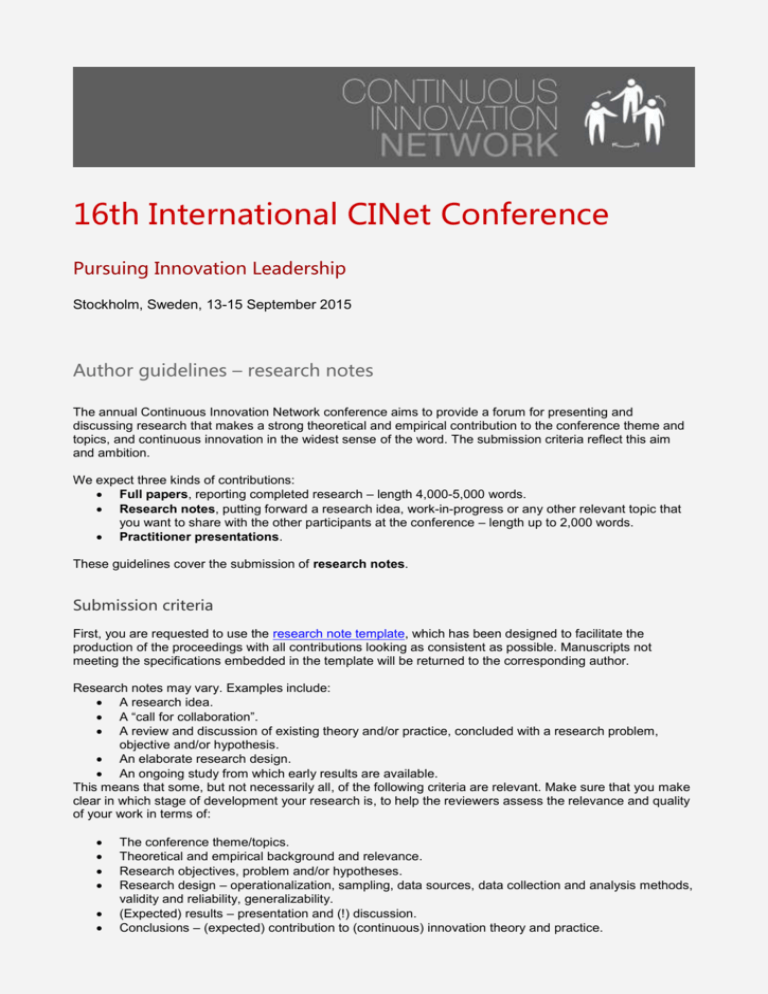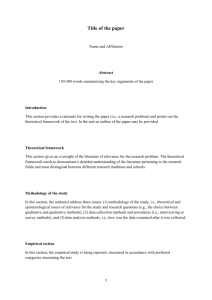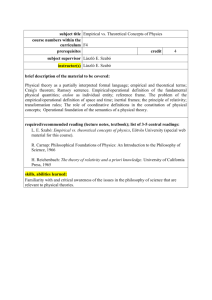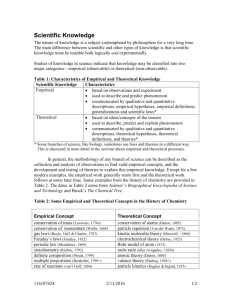cinet2015-author-guidelines-research-notes
advertisement

16th International CINet Conference Pursuing Innovation Leadership Stockholm, Sweden, 13-15 September 2015 Author guidelines – research notes The annual Continuous Innovation Network conference aims to provide a forum for presenting and discussing research that makes a strong theoretical and empirical contribution to the conference theme and topics, and continuous innovation in the widest sense of the word. The submission criteria reflect this aim and ambition. We expect three kinds of contributions: Full papers, reporting completed research – length 4,000-5,000 words. Research notes, putting forward a research idea, work-in-progress or any other relevant topic that you want to share with the other participants at the conference – length up to 2,000 words. Practitioner presentations. These guidelines cover the submission of research notes. Submission criteria First, you are requested to use the research note template, which has been designed to facilitate the production of the proceedings with all contributions looking as consistent as possible. Manuscripts not meeting the specifications embedded in the template will be returned to the corresponding author. Research notes may vary. Examples include: A research idea. A “call for collaboration”. A review and discussion of existing theory and/or practice, concluded with a research problem, objective and/or hypothesis. An elaborate research design. An ongoing study from which early results are available. This means that some, but not necessarily all, of the following criteria are relevant. Make sure that you make clear in which stage of development your research is, to help the reviewers assess the relevance and quality of your work in terms of: The conference theme/topics. Theoretical and empirical background and relevance. Research objectives, problem and/or hypotheses. Research design – operationalization, sampling, data sources, data collection and analysis methods, validity and reliability, generalizability. (Expected) results – presentation and (!) discussion. Conclusions – (expected) contribution to (continuous) innovation theory and practice. Limitations and implications for further research. The conference theme/topics – The conference each year has an overall theme and several topical session tracks related to the theme and (continuous) innovation in the widest sense of the word. In structuring your manuscript you need to ensure that it fits with the theme of the conference and is suitable for one of the session tracks. A high-quality research note might be rejected if it is outside the scope of the conference. Theoretical and empirical background and relevance – Describe and discuss the theoretical and empirical considerations behind your (intended, ongoing) research or topic you want to put forward and discuss. Draw on literature that is relevant to studies of continuous innovation and adjacent fields. References to theory should be clear and explicit, and allow for a clear positioning of the contribution of the research note. Address the question why the research (idea) is important from a practical perspective. Clarify the significance of your research (idea). Is it new and large enough? Is it interesting and important? For whom (researchers, practitioners)? Research objectives, problem and/or hypotheses – Be as explicit as possible in saying what you want to achieve with your research (idea). Research design If your research note is a research design or reports work-in-progress: How did / will you operationalize your research objective, problem and/or hypotheses? What sampling techniques and criteria did / will you use, and why? How large and representative is (will) your sample (be)? What techniques did / will you use to collect the data, and why? When and where was the data collected? What techniques did / will you use to analyze was the data, and why? How did / will you ensure the validity and reliability (or, alternatively, credibility, transferability, dependability and confirmability, or usefulness and usability) of your research? How did / will you deal with generalizability? If your research note is a literature review: How did you design your literature study? What criteria did you use to selection of databases, journals and why? What search terms/strings did you use and why? What inclusion and exclusion criteria did you use and why? How did you do the coding? How did you analyze the articles eventually selected? What are the results of your analyses? What are implications for (further) research? If your research note proposes a research idea, is intended to invite research collaboration, or addresses any other topic of interest, you also need to address any design/methodological issues that are of relevance for your readership to understand and assess your purposes. (Expected) results – Present any (expected) results in sufficient detail to allow your readers to draw their own conclusions and assess if your analysis has been or will be appropriate and sufficient. Also, include a discussion in which you explain how you intend to address or have addressed the research problems/ objectives, by situating the results and linking them to the theoretical and empirical background. A discussion without references to existing theory and practice is not a discussion. This is where many papers fall short. Conclusions – Clearly point out the contribution of your research note to (continuous) innovation theory and practice (or, for example, methodology or research collaboration). Address the limitations of, and questions emerging from, your (intended) study, as well as the implications (of these limitations and questions) for further research. References – A complete list of references should be provided at the end of the paper. Research notes without such a list will not be accepted. Length – Your research note should not be longer than 2,000 words – figures, tables, list of references and appendices included. If your research note meets these criteria, it will be accepted for inclusion in the conference proceedings on the understanding that it is an original work and has not been copyrighted, published, or accepted for presentation at any other conference. We look forward to welcoming you to Stockholm!









